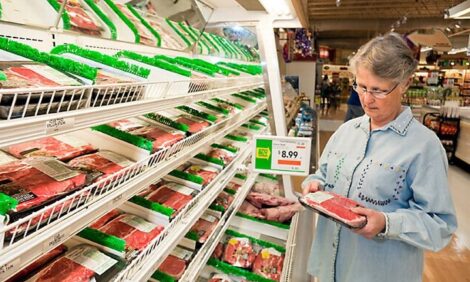



NADIS Pig Veterinary Report and Forecast - July 2007
UK - This is a monthly report from the National Animal Disease Information Service (NADIS), looking at the data collected from their UK farm inspections.Adults
Few health problems in adults were commented upon by NADIS reporting veterinary surgeons in June although PRRS continues to grumble along affecting productivity of the breeding herd. Recent data suggests that approximately one third of all breeding herds with PRRS use active vaccination programmes to some degree.
Other breeding problems noted in the month included:
- Poor fertility associated with service management errors
- ‘Late drop out’ issues and errors relating to pregnancy diagnosis
- Delayed weaning to service intervals resulting from extensive cross fostering and extended lactation
- Excessive weight loss in lactation leading to thin sows at 2nd parity
Piglets
Again a relatively quiet time in the farrowing area with the most interesting issues being:- Congenital tremor as an underlying grumbling problem rather than an explosive outbreak, calling into question the suitability of acclimatisation procedures.
- High piglet mortality particularly associated with a high proportion of old sows returned in a herd which were not capable of rearing full litters. Age structure of a herd is regularly highlighted as the root cause of substandard breeding herd production.
- Stillbirths. With warm weather early in the month, excess sow condition and older sow stillbirths are still a regular feature.
- An acute outbreak of 10 day old piglet enteritis producing rapid death was noticeable for a lack of a definitive diagnosis. E.Coli would be expected to be the most likely cause of such a problem but in this case was not implicated by laboratory testing.
Weaners
As in previous months, the feeding herd dominates the health and production reports received. Meningitis, with or without associated joint ill and lameness, was highlighted in a number of cases. This may be in part triggered by the very high humidity levels experienced in the month and the highly variable weather conditions.
A number of herds were reported to be winding down to closure and confirming the on-going consolidation of the industry. Severe complex respiratory disease was highlighted as the principle problem in such herds with the usual suspects implicated – enzootic pneumonia, Actinobacillis pleuropneumonia and Glassers disease ‘piggybacking’ on . Unusually, Atrophic Rhinitis – a disease rarely seen in the UK today – was also implicated.
Scour also featured prominently both as an immediate post-weaning problem – although with some note of achievement of good control well as early grower scour/colitis involving ileitis, salmonella, hygiene and nutrition.
There have been some reports of sudden and substantial improvements in sow fertility (usually for management reasons) leading to a surge of farrowings and pressure on farrowings accommodation. In some cases this has led to the weaning of undersize, young and substandard pigs at weaning which then struggle to thrive. This is a useful reminder of the interrelationships that exist and the fact that success at one stage can actually lead to problems elsewhere.
Grower Finishers
The finishing herd continues to be dominated by mixed respiratory diseases and scouring, with the latter due to ileitis, colitis and swine dysentery. Late onset PMWS and PDNS were also commonly reported with respiratory or enteric complications frequent.
A number of cases of septic arthritis were scattered through the month, along with spinal deformities producing humped back/dipped shoulders. Erysipelas – presenting as classic diamonds – was reported typically in straw yard systems, with bird contamination of feeders a feature.
Non infectious problems of interest highlighted during the month included:
- A number of outbreaks of tail biting on top of the ‘normal’ underlying incidence.
- Unchecked hernias causing marketing difficulties.
- Stomach ulcers associated in some cases with acute fatal gastric haemorrhage but in others singly detected at slaughter. Feed format and in particular size of cereal grist was commented on as being implicated.
- Riding problem in boars – again particularly in yards – with penile damage from biting as a frequent complication. Through the second half of the summer producers should be aware of the following:
- Infertility either due to hot weather or following reducing day length beyond mid-September.
- Erysipelas especially in straw yards.
- Farrowing house scours if pen hygiene is compromised in hot weather.
- Overcrowding as herd productivity improves.








